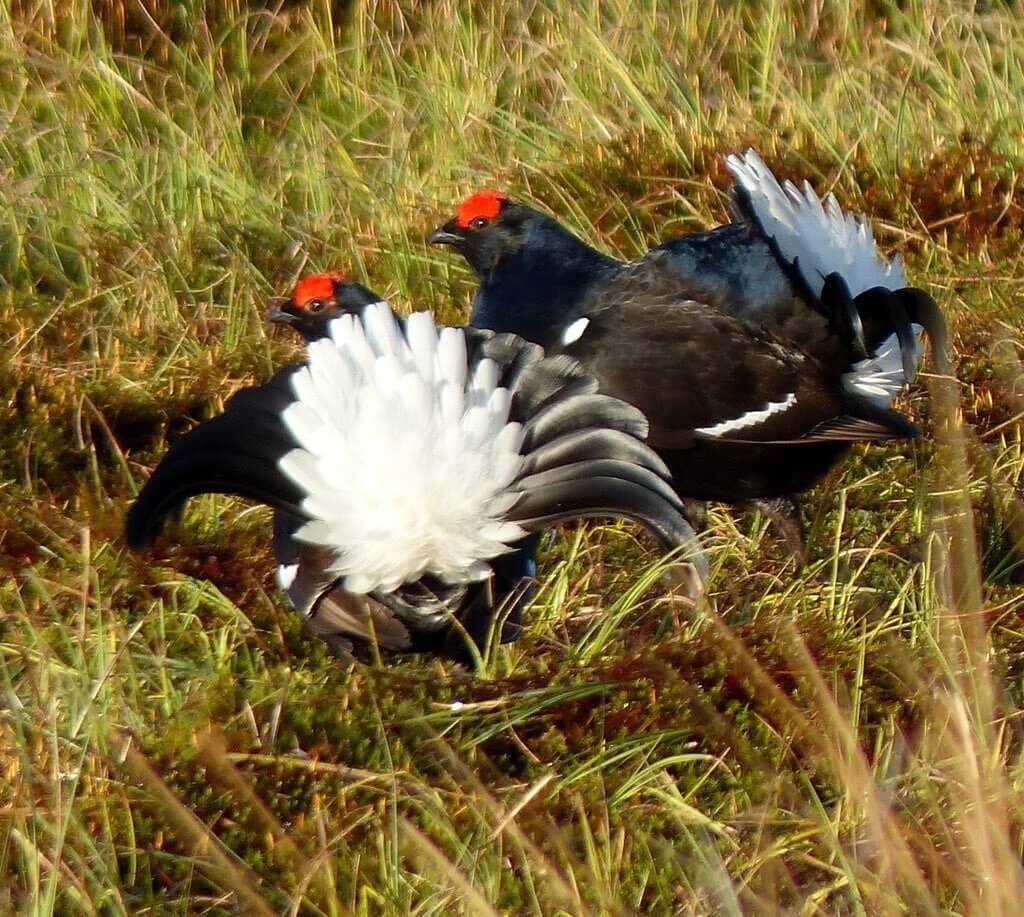
Yesterday morning, as the light grew but before sunrise, I was looking at one of the greatest birding spectacles on offer in the UK – a Black Grouse lek.
I was in North Wales with friends and expert bird guides Alan Davies and Ruth Miller and the displaying male Black Grouse were only 20m away. We sat in the car and watched as well over a dozen males strutted their stuff with spread and erect tail feathers on the mixture of grass and heather. Each male stuck to a relatively small area of the display ground but as one watched there was always something going on; neighbours displayed at each other, a male would make a short run through the grass or a couple of males would have a brief scuffle.
And these males are handsome beasts (and don’t they just know it?) with their red wattles, dark blue necks and chests, black-brown bodies, lyre-shaped tail feathers and ultra-white backsides. As we approached the lek in the dim light we could see those white-bottomed black shapes moving in the distance.
There was not a female in sight, it’s a bit early in the year for them to be interested in the males, but these males wouldn’t be putting in the hours gathering together, displaying like crazy things were it not for the fact that this is where females will arrive to mate with their chosen male before heading off to lay eggs and rear their young alone. All this action wasn’t for us, although we were enjoying it immensely, but for females who weren’t present right then and might not show up for several days or even a couple of weeks.
And as we sat watching, with the car windows open and the cold Welsh mountain air rapidly displacing the fug that had built up as we travelled, in hope, to this scene, the air was filled with the sounds of the displaying males. They make quite a lot of noise. There’s a mixture of bubbly purring notes and lots of harsh hissing going on. Whereas one can watch what an individual male does in terms of its visual display I found it impossible to pick out an individual’s song. Because birds don’t open and close their mouths like human singers would have to, it’s very difficult to work out which Black Grouse male is singing the most or singing the best – but I bet the males all know, and even more importantly, I bet the females work it out pretty quickly too when they turn up.
The biologist in me wanted to understand and explain everything that happens (if only to myself and in my own thoughts) and the birder just wanted to enjoy it. The birder won.
This Tuesday morning I am sitting at my computer in east Northants in the warm. Yesterday at this time I was sitting in a cold car in North Wales watching a Black Grouse lek. Those Black Grouse are almost certainly strutting their stuff and making those noises right now as I write these words about them. And they’ve been doing it for thousands of years, and they might do it for thousands more if we let them. They aren’t doing it for us but we can dip into their lives and thrill at the natural world around us.
Thank you Ruth and Alan for your expert guiding (see here) and thank you to Andrew too for his friendly companionship through the day’s birding. More on this later today.
[registration_form]
It is amazing that Black Grouse are seen as bad as Hen Harriers by many Red Grouse keepers for disrupting a drive. This costs the keeper a lot of money in ‘back hands’ which is mainly cash which is undeclared to the tax man. Nests are still stamped on and the Black Grouse habitat destroyed even in the latest Langholm project where the ‘white ground’ was fenced and cattle brought in to brake up the ground for even more heather to come in. Even here there was the demand to cut down Birch as it interfered with the open ground preferred for Red Grouse. The latest Merlin paper covering 30 years work shows how bad some of these moors are becoming for other species!
Is this a first? This blog has no dislikes!